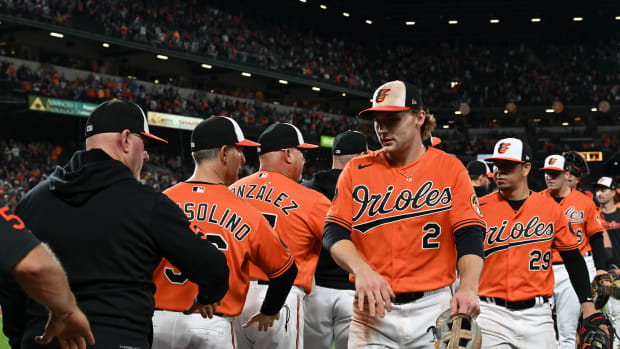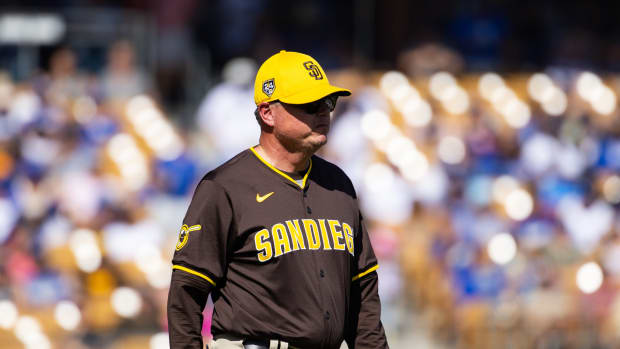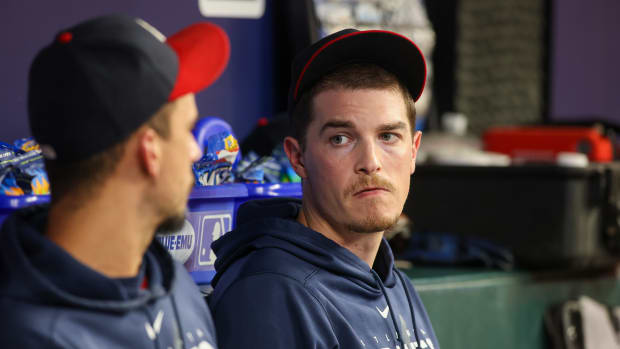The Nine Players I Voted for on my 2018 Hall of Fame Ballot
The doors of Cooperstown are swinging open wider than ever, despite the constant whining about the system. Voting results announced Wednesday could see as many as five players voted into the Hall of Fame by the Baseball Writers Association, tying the record from in the inaugural class of 1936. Even three inductees will make for 15 players voted in by the writers within the past five years, more than in the 10 years previous.
Chipper Jones, Jim Thome and Vladimir Guerrero appear to have strong enough support to clear the 75% threshold needed for enshrinement, according to the ballot-gathering info of Ryan Thibodaux. The real drama is about Trevor Hoffman (five votes short last year) and Edgar Martinez (73 votes short, but riding a surge).
Much of the noise again has been about players connected to steroids, while too many deserving players never connected to steroids get overlooked. The uneven playing field continues even in retirement.
My ballot is below. I never have and never will vote for players connected to steroid use by public evidence. At no point, rule or no rule, was steroid use acceptable, which is why players went through great lengths to conceal it and continue to do so years later. I understand why some players made the choice. I cannot honor it.
As time passes, and voters who were in middle school when The Steroid Era raged join the electorate, the insidiousness of the era wanes. Barry Bonds and Roger Clemens are getting 50–60% of the overall vote, but over the past two years they are getting 88–92% of the first-time vote. As needed refreshers, here are two telling quotes from 2012:
Dan Naulty, a fringe player turned flamethrowing reliever only because of steroids, told me, “I was a full-blown cheater, and I knew it. You didn't need a written rule. I was violating clear principles that were laid down within the rules. I understood I was violating implicit principles.”
And Mark McGwire, on what steroid use should mean for the greatest honor in the sport: “It’s a mistake that I have to live with for the rest of my life. I have to deal with never, ever getting into the Hall of Fame. I totally understand and totally respect their opinion and I will never, ever push it. That is the way it’s going to be and I can live with that. One of the hardest things I had to do this year was sit down with my nine- and ten-year-old boys and tell them what dad did. That was a really hard thing to do but I did it. They understood as much as a nine or ten year old could. It’s just something, if any ballplayer ever came up to me, run away from it. It’s not good. Run away from it.”
I voted for nine players. Here they are:
Chipper Jones
He was the definition of a franchise player. Jones is the only player drafted first overall who never played for another major league team. He is the first player since Frankie Frisch, who was born in 1897, to hit .300 from both sides of the plate. And he is one of only six players—and the only switch hitter—to slash .300/.400/.500 over more than 10,000 times at bat. The others: Ty Cobb, Babe Ruth, Tris Speaker, Mel Ott and Stan Musial.
Vlad Guerrero
Few players were ever better at combining the two offensive tools that define a five-tool player: hitting for average and hitting for power. Guerrero hit .318 with 449 home runs. He is the only player born in the past 97 years to reach those thresholds. The only ones to do so who were born before then were Babe Ruth, Lou Gehrig, Jimmie Foxx, Ted Williams and Stan Musial. Here is the definition of a Hall of Fame prime: for 11 straight seasons (1998–2008) he received MVP votes or was selected to the All-Star Game while averaging .325 with 35 homers and 112 RBI.
While The Numbers Don't Always Support It, Trevor Hoffman Will Likely Secure a Hall of Fame Spot
Trevor Hoffman
The most valuable currency in major league baseball is the team win. And only Mariano Rivera was trusted more often with making sure a win in hand stayed in hand. Nobody else was close. Teams do not keep giving save opportunities out of charity. Hoffman was entrusted with a save 677 times—in a physically and mentally grinding job that wears down the many 30-save closers who come and go. Hoffman was a true outlier at his position. Other than Rivera—and even realizing the flaws within the save stat—Hoffman has 26% more saves (601) than any other pitcher in history.
Jeff Kent
He hit more home runs, drove in 100 runs more times, and batted cleanup more times than any second baseman in history. His numbers blow away those of Ryne Sandberg—and yet, in one of the more absurd voting results, Kent never has received even 17% of the vote. This is his fifth try. With nobody running a “campaign” for him—not much of a likable guy, never stayed long enough with one team—he’s not getting in.
Edgar Martinez
He is a borderline Hall of Famer because he has no significant defensive contribution and was not reliably healthy—even in the best 10-year stretch of his career he missed 33 games a year on average. But he did put up eight monster qualified seasons with an OPS+ of 150 or better, which ties him with Dick Allen for the most such seasons among those not voted in and not connected to steroids, and he did spend his entire career with one team, which voters love. The opinions of his contemporaries on the brilliance of his hitting, especially from pitchers like Rivera, helped convince me.
Martinez’s election would be groundbreaking—not because he was a DH, but because he didn’t play that long. Among players who broke in after 1947 (not including pitchers and catchers), the writers have voted in only one player with fewer than 9,000 plate appearances: Kirby Puckett, whose career was cut short by injury.
Fred McGriff
He is the victim of the biggest voting farce of the BBWAA, particularly from steroid apologists who don’t give McGriff a fair look. McGriff is one of only 23 Hall of Fame eligible players in the history of baseball who came to bat 10,000 times and posted an OPS+ of 134 or greater. After this vote, with Jones and Thome getting in, McGriff will be the only one of those 23 not in the Hall of Fame who has not been connected to steroids (Barry Bonds and Gary Sheffield are the two steroid-tainted ones in that group)—and he’s never been close.
Compared to newly inducted Hall of Famer Jeff Bagwell, McGriff has more games, runs, hits, home runs, runs batted in and All-Star appearances; more top five seasons in home runs, OPS, and runs created; a far, far better postseason resume; and the same number of Top 10 MVP finishes. And yet McGriff never has received even 25% of the vote.
This is his penultimate year on the writers’ ballot. He’s not getting in. Nobody has been harmed in the voting in more ways—by the 1994–95 strike (which cost him 500 homers), by steroids taking root around him (he won home run titles with 35 and 36 homers in 1989 and 1992, then finished 17th in 1999 with 32) and by never playing more than five seasons with one team.
Mike Mussina
There are only a dozen pitchers who ever posted 10 qualified seasons with an ERA+ of 125 or greater. Ten of them are in the Hall of Fame: Lefty Grove, Walter Johnson, Greg Maddux, Pete Alexander, Christy Mathewson, Randy Johnson, Bert Blyleven, Jim Palmer and Tom Seaver. The only two not in the Hall are Mussina and the steroid-tainted Clemens.
I don’t get why he’s not in yet. Mussina finished more than a hundred wins over .500, had more top five ERA seasons than Tom Glavine or John Smoltz, made 60% of his career starts in Camden Yards, Yankee Stadium and Fenway Park, is the only premier starting pitcher to pitch entirely in the AL East throughout The Steroid Era, and has won more American League games in The DH Era than every man except Clemens.
Roger Clemens, Arguably the Greatest Pitcher of All-Time, Is Trending Toward Hall of Fame Induction
Curt Schilling
The man changed baseball history. He is Don Drysdale with a better postseason resume. Schilling took the ball five times with his team facing elimination in the postseason. His team won every time it handed him the ball in those do-or-die spots, during which Schilling was 4–0 with a 1.37 ERA. You would think the starting pitcher with the greatest strikeout-to-walk rate since 1889, when the distance between the mound and the plate was set at 60 feet, six inches, would be in the Hall of Fame already. He will be 0-for-6 after this ballot.
Jim Thome
He hit 612 homers and wasn’t connected to steroids. That’s enough a Hall of Famer, even though he didn’t hit lefties, or late in games, or in the postseason, and never factored in MVP voting (never in the top three and not one first-place vote in 22 years). He stayed healthy and he kept hitting homers—more after age 30 than anyone not connected to steroids except Babe Ruth, Hank Aaron and Willie Mays.
The magic number for home runs is not 500, but 475. Thome is the 22nd player to appear on a Hall of Fame ballot to hit 475 or more home runs with no connection to steroids. Every one of them is a Hall of Famer except one—Fred McGriff.



































